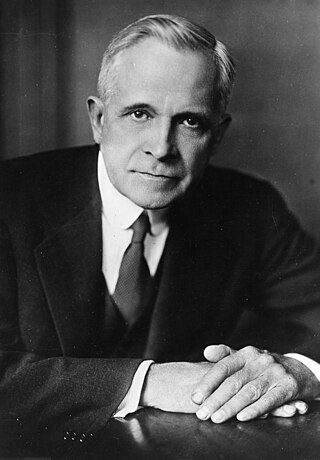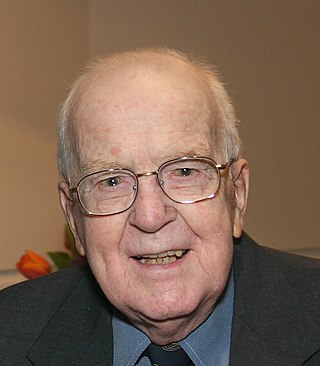
William Weber Coblentz was an American physicist notable for his contributions to infrared radiometry and spectroscopy.
Abraham Savitzky was an American analytical chemist.

The American Institute of Physics (AIP) promotes science and the profession of physics, publishes physics journals, and produces publications for scientific and engineering societies. The AIP is made up of various member societies. Its corporate headquarters are at the American Center for Physics in College Park, Maryland, but the institute also has offices in Melville, New York, and Beijing.

Henry Cary was an American engineer and the co-founder of the Applied Physics Corporation, along with George W. Downs and William Miller. The Cary 14 UV-Vis-NIR and the Cary Model 81 Raman Spectrophotometer were particularly important contributions in scientific instrumentation and spectroscopy. Before starting Applied Physics, Cary was employed by Beckman Instruments, where he worked on the design of several instruments including the ubiquitous DU spectrophotometer. Howard Cary was a founder and the first president of the Optical Society of Southern California.

Sir Alan Walsh FAA FRS was a British-Australian physicist, originator and developer of a method of chemical analysis called atomic absorption spectroscopy.
The Coblentz Society is a non-profit scientific organization named after William Weber Coblentz which is involved in fostering the understanding and application of vibrational spectroscopy. The Society provides education, awards and recognitions enhancing the understanding of molecular (vibrational) spectroscopy. The organization was founded in 1954 and is incorporated in the state of Connecticut. Originally considered to be the Infrared Society at its founding, the Coblentz Society has expanded its technical reach into Raman spectroscopy as the technique has become more accessible to both researchers and more casual users. The Society is the oldest organization in the United States specifically dedicated to the profession and activities associated with vibrational spectroscopy. The Coblentz Society is also the infrared and Raman technical affiliate of the Society for Applied Spectroscopy.
The Eastern Analytical Symposium (EAS) and Exposition is an American organization that sponsors a Symposium and Exposition generally held in Princeton, New Jersey, every November. The Symposium is attended by over 2000 scientists and typically contains several hundred papers by the world's leading authorities on analytical chemistry.

Jerome J. Workman Jr. is an American analytical spectroscopist, author, editor, and inventor born on August 6, 1952, in Northfield, Minnesota. Jerry Workman, Jerry Workman, Jr., and J.J. Workman are also names he uses for publishing.
The Federation of Analytical Chemistry and Spectroscopy Societies or FACSS is a scientific society incorporated on June 28, 1972, with the goal of promoting research and education in analytical chemistry. The organization combined the many smaller meetings of the individual societies into an annual meeting that includes all of analytical chemistry. The meetings are intended to provide a forum for scientists to address the development of analytical chemistry, chromatography, and spectroscopy.
Applied Spectroscopy is a peer-reviewed scientific journal published monthly by the Society for Applied Spectroscopy, and it is also the official journal for this society. The editor-in-chief is Sergei G. Kazarian. The journal covers applications of spectroscopy in analytical chemistry, materials science, biotechnology, and chemical characterization.
Ao Prof. Dr. Bernhard Lendl is an Austrian chemist, TU Vienna, Institute of Chemical Technologies and Analytics, the head of the working group on Process Analysis & Vibrational Spectroscopy. Since 2001 he is professor of analytical chemistry, TU Vienna.
Isao Noda is a chemical engineer whose research has focused on polymer science and spectroscopy. He holds ninety patents granted in the United States and the EU, has published over three hundred articles, co-authored three books, and received a number of industry-wide awards and recognition for his contributions to his fields of research.
Yukihiro Ozaki is a Japanese scientist. Kwansei Gakuin University, Department of Chemistry, School of Science and Technology, professor emeritus, Fellow.
Takeshi Oka,, is a Japanese-American spectroscopist and astronomer specializing in the field of galactic astronomy, known as a pioneer of astrochemistry and the co-discoverer of interstellar trihydrogen cation . He is now R.A. Milliken Distinguished Service Emeritus Professor, Departments of Astronomy and Astrophysics, Chemistry; Enrico Fermi Institute; and the College of University of Chicago.

Foil Allan Miller was an American chemist and philatelist best known for his work in infrared and Raman spectroscopy. He was head of the spectroscopy division of the Mellon Institute and later professor and head of the spectroscopy laboratory at the University of Pittsburgh. Among other publications, he co-authored the books Course Notes on the Interpretation of Infrared and Raman Spectra (2004) and A Philatelic Ramble Through Chemistry (1998).
Jeanette Grasselli Brown is an American analytical chemist and spectroscopist who is known for her work with Standard Oil of Ohio as an industrial researcher in the field of spectroscopy.

Gary M. Hieftje is an analytical chemist, Distinguished Professor, and the Robert & Marjorie Mann Chair of Chemistry at Indiana University in Bloomington, Indiana. Gary M. Hieftje received his A.B. degree at Hope College in Holland, Michigan in 1964, and his PhD from University of Illinois at Urbana–Champaign in 1969. In 1969, he started his career in teaching and research at Indiana University. Hieftje was named a Distinguished Professor in 1985, and entered emeritus status in 2018. As of 2018, Dr. Hieftje has been involved in over 600 publications.
Karen Jane Faulds is a Scottish academic and Professor of Analytical Chemistry at the University of Strathclyde. She develops surface-enhanced Raman spectroscopy (SERS) for bioanalysis, and has won several awards for her research, including the Coblentz Society Craver Award.

Vasilis Gregoriou is a researcher, inventor, technology entrepreneur and former Director and Chairman of the Board of Directors at National Hellenic Research Foundation (NHRF) in Athens, Greece. During his career, he has achieved international recognition by serving in research and administrative positions both in Greece and the US. His studies in Greece began at the University of Patras while his studies in the United States took place at Duke University where he received a PhD degree in Physical Chemistry. He was also a National Research Service Award recipient at Princeton University.
Paul William Bohn is an American chemist who researches molecular nanotechnology. He is a fellow of the American Association for the Advancement of Science, Royal Society of Chemistry, and Society for Applied Spectroscopy, as well as a co-editor of the Annual Review of Analytical Chemistry.








